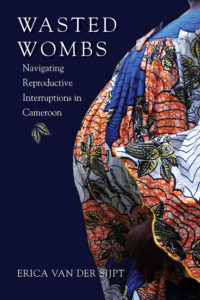Reviewed Book
Wasted Wombs: Navigating Reproductive Interruptions in Cameroon. Erica van der Sijpt, Nashville: Vanderbilt University Press, 2018, 280 pp.

In Wasted Wombs, Erica van der Sijpt explores the logics mediating sex, marriage, conception, pregnancy, fetal loss, and female agency among the Gbigbil of eastern Cameroon. The notion of reproductive uncertainty and possible redirection—what van der Sijpt terms “reproductive conjunctures”—undergird this deeply ethnographic text. These reproductive conjunctures bring to the fore a woman’s reproductive history, present constraints and possibilities, and future aspirations. They are also moments made meaningful through careful manipulation by women who are looking to secure a future in a highly uncertain environment.
To understand the context within which reproductive interruptions are made meaningful, van der Sijpt situates readers in contemporary Cameroon, which has been shaped by forces of globalization, economic dependency, contested international intervention, urban migration, and social change. These processes have disrupted local marriage customs, resulting in more permissive sexual boundaries and thus allowing women more agency but also ushering more instability and uncertainty into their lives. Due to these disruptions, women’s reproductive aspirations, including their notions of how welcome a pregnancy might be at any particular moment, are changeable and contradicting. Throughout the text, van der Sijpt dismantles the concept of static desires, positions, and intentions.
Mirroring accounts from across the continent of ambiguous and constantly negotiated timelines, pregnancies haunted by risks of the occult, and idealized (if not always practiced) solitary births, van der Sijpt portrays pregnancy as a highly contingent moment in the Gbigbil world. Fetal loss was common among the women van der Sijpt came to know in eastern Cameroon. These women experienced numerous stillbirths, miscarriages, abortions, or perinatal and neonatal deaths—various manifestations of a “wasted womb.” Because the outcome of a pregnancy could never be assumed, there was significant flexibility in interpretations when reproduction went awry. Lost pregnancies, depending on intention, could be interpreted by a woman as “just water” or as the loss of a potential child. Similarly, the intentional termination of a pregnancy was not viewed as categorically different than an unintentional loss. As van der Sijpt explained, “All fertility interruptions make potential lives leave, and they all leave a woman’s life with less potential” (p. 95).
The author questions the utility of discreet categorizations bounded by intentionality or time. Among the Gbigbil, we learn, viability is dependent not on fixed time-frames, but on characteristics of the individual fetus, such as its life force, often determined by the father’s contribution. These Gbigbil beliefs allow women the moral space to selectively terminate (or “unblock”) pregnancies that are not yet conceptualized as pregnancies, but rather as potential pregnancies. Similarly, the flexibility in gestational time-frames—where some pregnancies may last seven months and others 10, for example—allow women the space to negotiate multiple sexual partnerships and choose which partner (and family lineage) the pregnancies and future children will be attributed to.
Reproductive interruptions occur in a context of romantic relationships defined by mutual mistrust and manipulation, where husbands hedge their bets with multiple women, and wives, too, seek multiple partnerships—particularly profitable liaisons with “big fish” in urban areas. Reproductive interruptions thus complicate already fraught and flexible marital relationships. Van der Sijpt shows Gbigbil women as highly vulnerable, both bodily, during reproduction gone awry, and socially, as outsiders easily blamed in a patrilocal and patriarchal society. Yet, their vulnerability does not preclude their agency. In the absence of bride-price payments and within a context of largely informal and concurrent relationships, a Gbigbil woman often “plays” with her partners, strategically attributing a pregnancy to the man most able to provide for her and her future child. For some women, a pregnancy can be an opportunity to secure an otherwise unreliable relationship. (Men, too, we learn, are selective in their recognition and support of children attributed to them). Although women rely on idioms of powerlessness, submission, and suffering (and certainly do suffer from the constraints of a highly patriarchal society), van der Sijpt demonstrates how they deploy a “pragmatic improvisation” to actively manipulate partners, pregnancies, and larger social networks to achieve the desired outcomes of their reproductive presents.
Some may read Wasted Wombs as thin on theory and occasionally narrow in focus, but the care with which van der Sijpt untangles reproductive decision making and female agency in Cameroon is impressive. On one hand, because some of van der Sijpt’s findings may not feel particularly ground-breaking or theoretically novel, the book may be of limited value to more advanced graduate students or senior scholars already familiar with reproductive decision making in sub-Saharan Africa. On the other hand, the text could offer undergraduates in women studies courses a deep exploration of gendered expectations, reproductive agency, and active processes of meaning-making.